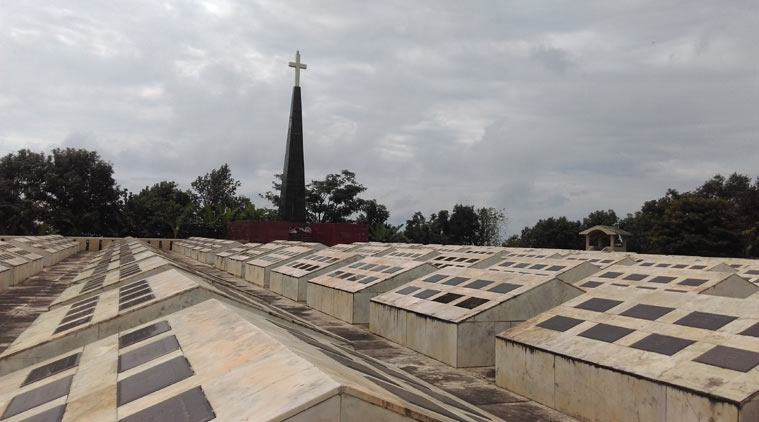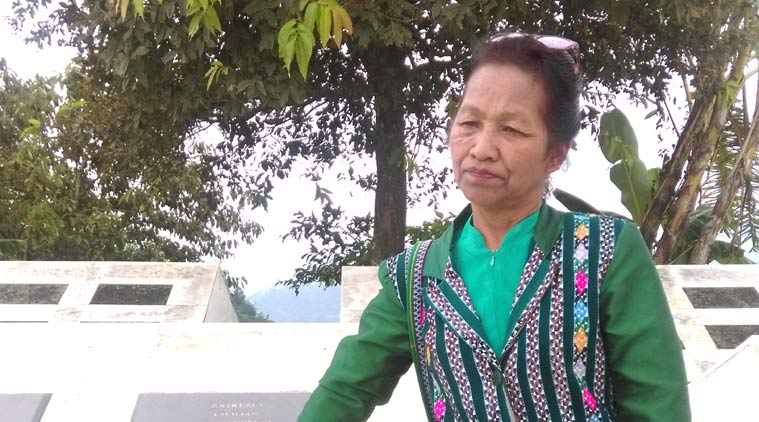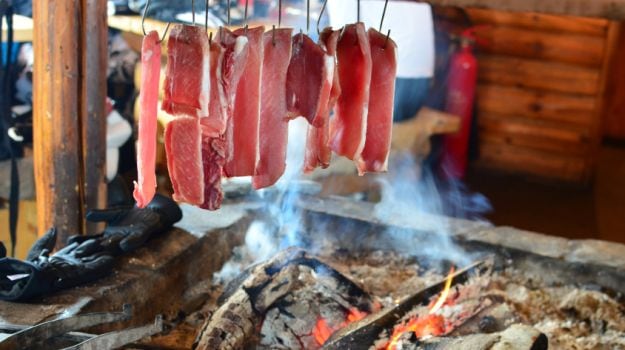By Prashant Jha
 Members of JAC in Churachandpur look at bills and allege it is anti-tribal. (Prashant Jha/HT Photo)
Members of JAC in Churachandpur look at bills and allege it is anti-tribal. (Prashant Jha/HT Photo)
Churachandpur/Imphal, Sep 8 : On Monday afternoon, it appeared as if the entire town of Churachandpur had descended on the district hospital.
Hundreds waited inside, a majority of them women, and many climbed up
the emergency and trauma centre building, peering out of windows. Young
men had their mobile phones cameras on as they stood patiently at the
gate. A convoy of motorbikes, SUVs, and finally, a large jeep of the
Young Vaiphei Association drove in.
En Khankhup was brought back home – but in a coffin, with a white shroud and a cross.
Women
wailed and men broke down as the body was brought out and kept in the
middle of the hospital. Community leaders paid their respects and then
made a public address. Khankhup joined eight others, fellow protestors
who had been killed during an agitation last week in Churachandpur, in a
morgue.
Lacking cold storage facilities, the morgue has been
equipped with two ACs, with 24-hour electricity supply arranged, as the
dead men wait for a political solution they failed to achieve in their
lives.
"Public opinion here is that we must not conduct the
burial ceremony till the government acts and fulfills our demands,
repeals the three laws, and gives us a separate administration. We
cannot trust the valley anymore," says Sasang Vaiphei of the Kuki
Students Organisation.
Meitei push for regulation
Manipur has been in the middle of political unrest for over two
months now. At the heart of it lie the three laws, which Vaiphei
referred to, and competing narratives around the issue between the
Meitei dominated valley and tribes dominated hill region. And underlying
it is a sense of fear on both sides, fueled by misunderstanding and
power imbalance.
People in the Imphal valley – Meiteis – had
been agitating for the introduction of the Inner Line Permit system.
This permit would regulate the entry of non-Manipuris into the state as
well as bar them from acquiring assets. One student was killed in police
firing on July 8 and this only gave the movement a further fillip.
Those
leading the protests claimed there had been a massive influx of
outsiders in the state, and their opportunities were being squeezed. An
Imphal police constable told HT, "The Biharis, Marwaris, and Punjabis
are doing business in the capital. We will be reduced to a minority in
our land."
There is an 'explosion of anxieties' in the valley,
says Pradip Panjhoubam, editor of the Imphal Free Press, a respected
Manipur daily. "They feel under siege. In the north, Naga districts want
to carve out and merge with Nagalim. The Naga accord has only made
people in the valley apprehensive about the implications for the state's
territorial integrity. Across the hills, they cannot buy land even
though people of the hills can buy land here. They also see what has
happened in other northeastern states with outsiders coming in. All of
this has added to paranoia and fear of being marginalised."
Eventually, the government passed the three bills to meet the concerns of the protestors. Among them two are contentious.
In
The Protection of Manipur People Bill, 2015, the 'people of Manipur'
have now been defined as those whose names are there in the official
records since 1951. Severe restrictions have been imposed on outsiders -
they now have to register with a directorate of the government as soon
as they entered the state and they would then be issued a pass for six
months, subject to extension. The directorate would also keep track of
all tenants.
A second act – which was actually an amendment to
the Manipur land revenue and land reforms bill – made land transaction
for non-Manipuris across the state contingent on state approval.
 At
the Churachandpur district hospital, a big crowd receives En Khankhup,
the ninth dead after violence last week. (Prashant Jha/HT Photo)
Tribal backlash
At
the Churachandpur district hospital, a big crowd receives En Khankhup,
the ninth dead after violence last week. (Prashant Jha/HT Photo)
Tribal backlash
This, however, triggered a backlash from the tribal groups in the
hill districts of the state – primarily the Kukis, Zomis and Chins, as
well as the Nagas – who saw it as 'anti-tribal'.
There is a
historical context here. Tribal groups have been deeply resentful of the
Meitei domination of the Manipur state structure, the overwhelming
concentration of resources and 'development' in the valley, and have
demanded separation from it. They also see the demand for the ILP as a
precursor to Meiteis asking for ST status since the other states which
have ILP are all tribal states. If Meiteis get it, this would eat into
the share of other tribal groups in reserved categories.
Thuampi,
an advocate in Churachandpur, explained to Hindustan Times the tribal
case against what he saw as inter-related bills. It did not help that
the government pushed ahead with the bill without consulting authorised
bodies like the Hill Areas Council.
The first issue was the
decision to have 1951 as the cut-off date – those registered in official
records before that year were to be people of Manipur, and those after
would be considered foreigners. "Very few tribals, if any, would be
registered in the Census. There was no access to the hills, very little
communication. If this is passed, we will all become foreigners."
This was the most widespread refrain we heard during conversations
with the tribals, angry that despite being here for generations, they
were facing the prospect of being termed outsiders. This in turn would
deprive them of services, access to opportunities and right to procure
assets.
The second objection, Thuampi said, was that the
amendment to the land revenue and reforms act did away with the
distinction between the hills and the valley.
At the outset, the
bill frames the debate in terms of hill versus valley question – while
the valley area is 10% of the state, and hills comprise 90%, 60% of the
people live in the valley which has a density of 730 while in the hills
it is 61. The bill then states that non-Manipur persons and entities who
want to purchase any land 'in the state of Manipur' shall submit an
application to the deputy commissioner of the district where the land is
to be purchased. The DC will solicit recommendation from the local
bodies and make inquiries and submit the application and report of the
inquiry to the state government and it is the state cabinet which will
have the authority to approve the transaction.
"Earlier, in the
case of the hills, Autonomous District Council was the final authority
for land transaction. This power has been given to the cabinet," said
Thaumpi. This in turn has given rise to a perception among tribal
activists that the land arrangements in the state are almost being
reversed; that since they would be categorised as non-Manipuris under
the first act, it would make it impossible for them to purchase land.
"And
while it makes it difficult for us to buy and sell land even in the
hills, the valley people can penetrate into the hills with state
permission. They want to commoditize our land, and destroy our culture,"
Lianzamung Tunsing, a member of the Joint Action Committee in
Churachandpur, told HT, a little distance away from the district
hospital.
The JAC is the umbrella civil society body of tribals negotiating with the government in the town now.
Violence to uneasy calm
It was in this backdrop that the violence erupted.
HT spoke
to government officials, who wished to remain anonymous, protesters, and
members of civil society to piece together the turn of violence in
Churachandpur.
On August 31, student outfits had called a bandh.
It went off peacefully and at 5pm government officials breathed a sigh
of relief. But within an hour, they began receiving calls from ministers
and MLAs of the region from Imphal, who said their homes were close to
being burnt.
Tribal protesters were angry at these leaders for
not opposing the bills in the legislature. It was also a rare moment
when different tribal student and civil society groups – especially
Kukis and Nagas who have been adversaries and rivals – had come together
against the bills.
Thousands had surrounded the homes of five
MLAs and one MP. The deputy commissioner's car was burnt while he was on
his way to the troubled sites. At some point, there seems to have been a
request for reinforcements and paramilitary forces were called in.
Clashes erupted and by the end of the evening, four people had died. Two
were killed in firing; one arsonist died when he could not come out of
one of the burning houses and one protester died in an accident.
 Protestors put up placards during a demonstration in Churachandpur. (Prashant Jha/HT Photo)
Protestors put up placards during a demonstration in Churachandpur. (Prashant Jha/HT Photo)
The
next day, protesters had again engaged in mass demonstrations and
defied the curfew. Even as the government and civil society were
negotiating, protests intensified. Here, narratives diverge.
Officials say that after a two-hour scuffle, agitators burnt down a
police station gate and were marching in. To defend themselves, police
personnel had no choice but to shoot, and four more people were killed.
Tribal activists, however, say that it was the police which had been
provocative, and engaged in ruthless suppression. To support their
version they show a video which indicates that cops were kicking
protestors with the butt of their rifle unprovoked.
The police response has fed into the tribal perception of being discriminated.
"For the valley, they use rubber bullets; for us, they use live
bullets. In the valley, one person dies after two months of agitation;
in the hills, nine people die after two days of protests. In the valley,
they use tear gas sporadically. In the hill, they even use expired tear
gas," a woman activist of a human rights said on the condition of
anonymity. She told HT they had decided only JAC members would speak to
the media.
Local officials are very keen to restore order, and
know they cannot do it without the citizens cooperating. The Imphal
government has sent the additional DGP to Churachandpur; he belongs to
the district and is a tribal. Authorities have reached out to the JAC,
which is keen on maintaining peace as well.
The most striking
element of the current peace approach is the presence of women's groups
at the forefront in all sensitive areas in the town. They carry
placards, which speak out against the bills and the police response; but
they are also a layer of protection from mob action and are protecting
public property. A police official says, "We are relying heavily on them
rather than deploying security forces. Their presence deters the
younger radicals."
Government clarification
But while there is uneasy peace, what remains unresolved is the politics.
A full week after the violence had erupted, N Ashok Kumar, secretary
to the chief minister of Manipur, issued a detailed clarification on
Monday.
The government statement asserted that as far as the 1951 cut-off in
the protection of manipur people bill was concerned, this was intended
only 'for outsiders/non Manipuri persons who migrated into the state
since 1951 and does not apply to the people of Manipur who were born and
lived in the state'.
Pointing to a provision of the act which says it does not apply to
the 'native people' of the state, the government said that native people
include all sections/tribes living in the hills and valleys of Manipur.
"The apprehension that the tribal people who were then residing but
not registered in the Census of 1951 cannot live in Manipur is totally
false and misleading."
The government has added that in case this clarification does not
convince people, they would be willing to amend the act, and so there is
'no need for panic'.
On the issue of the land bill, the government has said that this only applies to the areas where the original act is enforced.
"The bill does not affect the tribal areas of Manipur… MLR&LR
does not extend to the hill areas of Manipur and the present seventh
amendment does not, in any way, make any provision for the extension of
the Act to the Hill Areas."
It added that the people living in tribal areas need not fear at all.
Whether this clarification will work and how Imphal balances the
demands of the Meiteis with that of the deep grievances – real or
perceived – of the tribals will determine when peace returns to the
state as well as the nature of Manipur's future political order.
The dead men in the morgue are waiting.
 Women at a protest site in Churachandpur. (Prashant Jha/HT Photo)
Source: Hindustan Times
Women at a protest site in Churachandpur. (Prashant Jha/HT Photo)
Source: Hindustan Times











 Lalthianghlimi stands near the granite plaque commemorating her brother Zairemmawia. (Source: Express photo by Adam Halliday)
Lalthianghlimi stands near the granite plaque commemorating her brother Zairemmawia. (Source: Express photo by Adam Halliday)
































